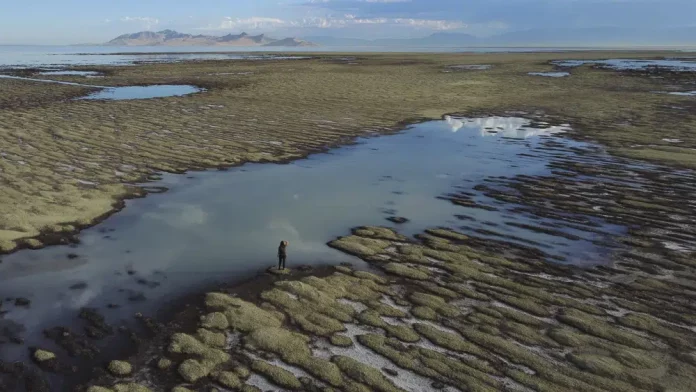
Utah’s Great Salt Lake may disappear within the next five years, experts predict. A Brigham Young University report found that as of January 2023, the lake is 19 feet below its average level. Since 1850, the Great Salt Lake has lost 73 percent of its water and more than half of its surface area.
BYU ecologist Benjamin Abbott, noting “unprecedented danger,” called for emergency measures to save the Great Salt Lake from further collapse. Abbott wrote that despite encouraging growth in legislative action and public awareness, “most Utahns do not realize the urgency of this crisis.”
At this point, and since 2020, the lake has lost more than 1 million acre-feet of water annually. Each acre-foot represents about 360 gallons of water, nearly the size of a one-foot-deep football field. Today, only about 0.1 million acre-feet of water is returned to the lake each year.
Abbott pointed to worldwide examples which show that saline lake loss triggers a long-term cycle of environmental, health, and economic suffering. He urges a coordinated rescue to stave off widespread air and water pollution, further losses from animals listed as part of the Endangered Species Act, and greater declines in agriculture, industry, and overall quality of life.
If Utah Governor Spencer Cox hopes to deliver on his promise that the Great Salt Lake will not go dry on his watch, he’ll have to adopt some if not all of Abbott’s suggested measures, many of which will be unpopular among constituents. Specifically, the BYU scholars called on Cox to implement a watershed-wide emergency rescue plan that will set a requirement of at least 2.5 million acre-feet per year until the lake reaches its minimum healthy elevation of 4,198 feet. In conclusion, and in light of what the authors called an “all-hands-on-deck emergency,” the BYU analysis asked farmers, counties, cities, businesses, churches, universities, and other organizations to “do everything in their power to reduce outdoor water use.” Utahns must, BYU counseled, adopt a “Lake First” approach to water preservation.
The Great Salt Lake’s rapidly dwindling water level is attributable to two factors: the ongoing drought that’s affected large swathes of the nation and an unprecedented population boom. Despite above-average snowfall in 2022, most of Utah remains in severe to extreme drought mode.
The bigger culprit in the Great Salt Lake’s demise, however, is population growth. Between July 2021 and July 2022, Utah’s estimated population grew by more than 61,000, which marked the state’s largest spike in absolute growth since 2006, putting its total population at slightly more than 3.4 million residents. Of Utah’s 29 counties, 28 added population, except for Daggett, which declined by six people. Utah’s population growth is calculated by the standard formula: net migration accounted for an estimated 38,141 more residents, while natural increase – births minus deaths – accounted for another 23,101 residents. From 2010 to 2020, Utah was the nation’s fastest-growing state. Utah’s growth will continue unabated. By 2060, Utah’s population will hit 5.5 million, with intervals of 4 million between 2032 and 2033 and 5 million between 2050 and 2051.
Put another way, in the next 40 years, Utah’s population will increase 66 percent.
By the time the 2030 Census rolls around, Utah will have more Venezuelan migrants admitted under President Joe Biden’s immigration policies. Already in Utah in significant numbers, Venezuelans are part of Biden’s program to grant immigration parole every month to 30,000 total Haitians, Cubans, Nicaraguans, and Venezuelans. For Venezuelans who have family ties and prospective sponsors in Utah, the state becomes a magnet. And once settled, the migrant Venezuelans will start families or expand their existing families, thereby putting more pressure on Utah’s natural resources.
The Great Salt Lake is one of many disappearing U.S. lakes and rivers, victimized by overpopulation and mismanagement. Others in grave danger of drying up include the Colorado and California’s Lake Mead and Lake Tahoe. BYU’s environmentalists have rolled out a sound plan to save the Great Salt Lake. For its part, the federal government is irresponsibly adding population to states like Utah that are struggling to provide precious water and other resources for existing residents.
Joe Guzzardi is a nationally syndicated newspaper columnist who writes about immigration and related social issues. Joe joined Progressives for Immigration Reform in 2018 as an analyst after a ten-year career directing media relations for Californians for Population Stabilization, where he also was a Senior Writing Fellow. A native Californian, Joe now lives in Pennsylvania. Contact him at jguzzardi@pfirdc.org.













